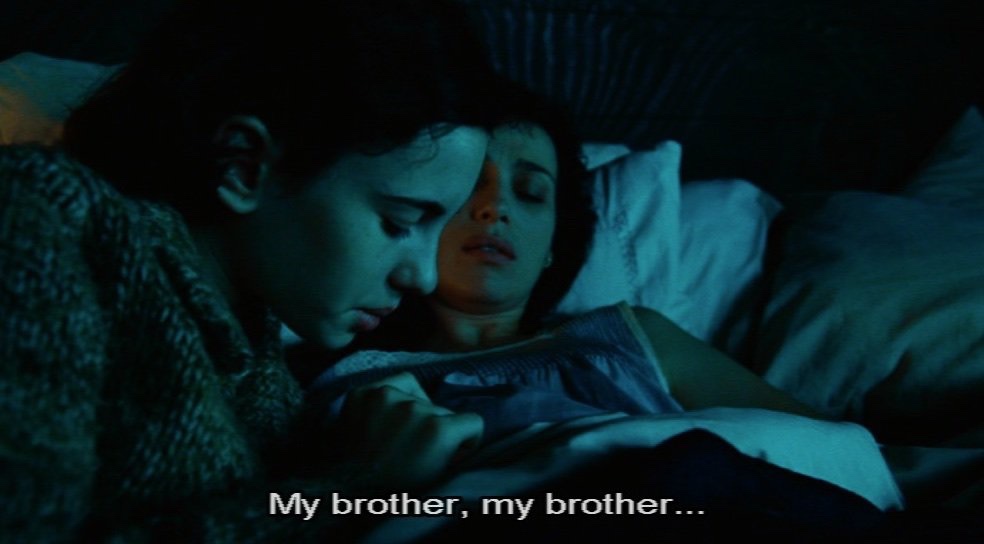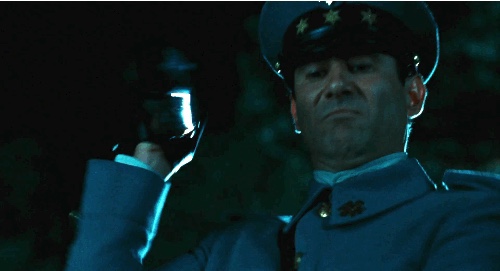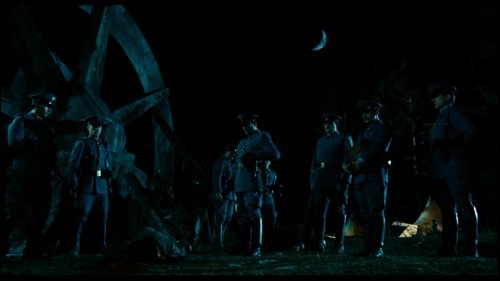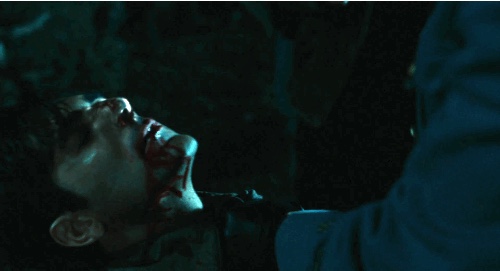Editing:
The shot where Ofelia and her mother are talking in the bed is one long and continuous shot. The director avoids cutting here to keep attention and focus on the two characters and their dialogue. The shot also slows down the pace of the film and prepares the audience to hear this story. The camera then pedestals downward in a fluid and floaty movement to create the feeling of a fairy-tale narration. The darkness on screen is used to make the transition and enter into Ofelia’s mothers womb, and then the camera dolly’s right and once again enters darkness to reveal the fairy-tale world. the same thing happens with the rose. It takes a moment to realise that the scene is now in a different environment, making it feel surreal and dream-like. The movement is created by the transitions and feels constant as it avoids making cuts and keeps moving throughout the sequence. It also makes the change from the CGI setting to a real one un-noticeable. The dream-like feel is also achieved by only using movements like pedestals and pans and crab shots. The transitions are fades, which blurs the line between reality and the fairy-tale.
The whole sequence is also done in continuity editing, since the events take place in chronological order. Finally the camera pedestals down to reveal the Captains room, once again secretly transitioning through the dark floor. A J-cut is used at the end of the scene to show the doctors reaction to the Captains threatening words, before cutting to the next scene. This also links the scenes together and establishes that no time has passed since the end of the scene with the doctor and the start of the scene with the farmers. A long take again slows down the pace of the film, creating a contrast between this and when the scene begins cutting rapidly as the farmer’s son is killed. The editing also matches the pace of the action, as here with an intense and violent burst of movement. The cuts between the Captain and the farmer’s son also shows his reaction, which is impassive and calm, to the disgusting act that he is committing. The pace of the editing also becomes sedate and slow as the action ends, matching, again, the movement of the characters.

Cinematography:
The room in which Ofelia and her mother are is very cold and dark, shown trough the blue tinted and silvery colour palette which also gives it a gloomy and dull atmosphere. It pans to the left to follow Ofelia and bring into frame the fireplace and bed. This serves as an establishing shot used to build the atmosphere of the room and follow Ofelia’s movements, keeping her as the centre of frame and therefore scene. When both characters are on the bed together a wide shot is used to keep focus on them and their dialogue, but also makes room for the darkness on the right side of the screen, building more atmosphere and tension. The shot also leaves plenty of empty space above the characters to create the feel of the large and empty room, and also makes makes the engravings on the bed frame clear to the audience. The camera slowly dolly’s forwards as the conversation continues, bringing the audience further into the scene.
The camera then pedestals downwards and transitions into a new environment. Then it crabs to the right and again transitions to a new place, pedestals down and crabs right, finally falling into an arch shot around the bed. These fluid and smooth movements make the scene play out like a story, which is narrated by Ofelia. Therefore, the camera movements contribute to the fairy-tale aspect of this scene, and almost makes it feel like a dream.

The doctor is kept at eye-level in the scene in the basement, perhaps to contrast how the Captain is usually above the camera in low-angle shots, and this subtly implies that the Captain is a better person that Vidal. Meanwhile, Vidal is sat in a chair shown to be looking up at the doctor, which signals that he has some dependancy on the doctor for looking after his wife and child. This changes after the captain stands up though, when he is once again shown from a low-angle shot. This and the over-the-shoulder shot from behind the Captain show how much taller the Captain is than the doctor, making him an intimidating presence and showing his superiority over the doctor. The soldiers are kept in the background and out of focus to keep the audiences attention on the doctor, but they are kept in frame to increase tension and block the exit, which gives the scene a tense and uncomfortable atmosphere.
The camera arch’s around the mill to follow the Captains movement, and the fact that he is between the two soldiers shows that he is the centre of focus for this scene. The shot of him searching the bag is long and goes not cut until he starts attacking the farmer’s son. This gives time for the situation to be explained by the soldiers, the farmers to plead their innocence, and tension to be built as Vidal searches their possessions. The dialogue establishes the stakes, and the shot makes for suspense building, and also illuminates the harm already done to the farmer, which implies that the soldiers are brutal and cruel. Vidal’s previous behaviour makes the audience wonder and fear to what extent he will punish the farmers if he finds anything too incriminating. The camera also slowly dolly’s forward again to build tension, immerse the audience, and establish how claustrophobic the farmers feel, completely surrounded by soldiers.

The camera quickly cuts between the Captain and the farmer’s son to show the violence that he is committing, and then the calm and neutral expression he wears on his face as he does it, showing how evil and cruel he is. One shot of Vidal also shows the farmer in the background, showing his reaction to the brutal scene in front of him, making the scene all the more stressful and intense. The low-angle shot makes it feel like Vidal is towering above us, making him all the more intimidating. There is also a close-up of the brutalised mans face to display how horrific the violence is. A wide shot is used to show how Vidal casually fires rounds into the two men, and how the soldiers just stand around, looking at this happen. Vidal is also always kept centre frame to show that he has authority and the centre of the attention in this scene. This displays Vidal’s authority, and the fear he puts into people, and how dangerous he is too.
The next shot is an over-the-shoulder from behind one of the soldiers, and this shows who Vidal is talking to, what his expression is, and the left side of the screen has space for the rabbit corpse in the bag, implying that Vidal murdered the two men for nothing. The shot then lingers on two soldiers to show how they reacted to the murders, and this imply that even Vidal’s own men are afraid of him, and opposed to his brutal actions/methods.
Sound:
As Ofelia walks from the door to the bed, diegetic sounds of her footsteps and the fireplace are comforting and homely, building a warm and safe atmosphere. The creaking and sounds from the house build a tense and eerie atmosphere, and the sound of laboured breathing from Ofelia’s mother implies that they are on edge. The non-diegetic score builds as Ofelia’s mother opens up to her about her loneliness. It is slow and somber, and prepares/signals the audience that there is about to be another scene in the fantasy world, and also emphasises the gothic tone of the film, and the emotions Ofelia and her mother are feeling.
When we see the baby, the heartbeat can be heard in the background, muffled and slow, and this is possibly done to show the relationship building between Ofelia and her brother. Diegetic wind and other cold, ambient sounds play, as the camera movements. This adds an ominous quality to the scene, and also adds to the sense of movement through the story, and the cold outside environment. The diegetic sounds of the insect increases the closer it is to the camera, immersing the audience. The sound of the score also gets louder as the scene goes on, and the choir like sounds to it give it a religious quality, that emphasises the beauty of the story, and lends it a small sense of truth.

When Vidal finishes fixing his watch, it begins ticking to a rhythm, showing that there is a purpose to it for Vidal, signifying importance. The sounds are also mechanical, creating a link between Vidal’s cruel and cold efficiency and the machine he holds. The ticking is also heard over the conversation about Ofelia’s mother, and this creates the sense that time is running out for her. As Vidal and his soldiers walk outside, the diegetic sounds of their footsteps create the atmosphere of the outside of the mill, and the Captains footsteps are louder than the others, implying authority and dominance, and get louder as he gets closer to the camera, making him seem more intimidating and making the audience feel like they are actually in the scene.
The important objects can be heard more, as with the watch and the bottle. The diegetic sound of the Captain slamming the bottle lid down implies that he has snapped, and lost patience. The diegetic sounds of the mans face being bashed in gets louder and wetter as the scene goes on, emphasising the gore and brutality, and creating more of an impact on the audience. The score also picks up here, making the situation more distressing and disturbing. The gunshots can also be heard echoing, once again building atmosphere and the dominance/authority of the Captain, and the fear he creates in people.
The non-diegetic score builds in intensity as the scene progresses, which makes the murder all the more hard to watch for the audience. The scene once again goes silent as Vidal walks away, slowing the pace and intensity of events, but still leaving the audience and the guards on edge from what trust happened.
Mise-en-scen:
The moonlight in the scene gives the room a gothic and theatrical feel. The design of the fire and the rest of the room is quite gothic, which builds atmosphere and adds to the tone of the room. The lighting on Ofelia and her mother is very soft and smooth, showing the warm and loving relationship between them. The bed frame also has a similar design to the underworld in the beginning of the film. It resembles goat horns or a uterus, which acts as symbolism and foreshadowing. The clothes that Ofelia is wearing is quite humble and simple and symbolises her as a kind person, who does not show off. The make-up on both characters is also naturalistic, and does not seem done-up or over-done, but genuine and reflective of the characters it’s on.
The blanket is black so that the un-seen transition can be made. The red colour of the womb matches that of the rose, dark and deep, allowing for another transition and creating a dark and ominous atmosphere. The hill that the rose sits on seems rough and brittle, implying danger and matching the narration of how people were scared to climb it, and the sky looks like a storm is brewing, making the atmosphere of the setting gloomy and grim. The thorny branches are also very foreboding and sharp.

The CGI gives the creatures and environment in the story scene seem fantastical and unreal. The basement is filled with gears and tools, which reflects the cold and precise efficiency with which Vidal operates. It also looks like a clock, which links to the stopwatch he is fixing in that scene. Vidal’s uniform is decorated and pristine, showing that he takes his profession seriously and is very strict with how he presents himself. The doctor is dressed well to show that he is professional and that the Captain trusts him, but is less done up and up-tight with his appearance.
The smoke coming off Vidal’s cigarette gives him an intimidating and confident appearance. It is also a symbol of wealth, to show that he is in control of the goods and resources that other people need and want, such as the peasants. The setting of the mill in the woods is similar to many old fantasy book and fairy tale tropes, which establishes an atmosphere for the film, and also makes the area feel more remote and isolated, therefore trapped and claustrophobic.
The soldiers all have clean and tidy uniforms, which reflects how obedient they are to the Captain. The farmers, on the other hand, have dirty and rugged outfits, which shows that they are poor, and provides a direct contrast to the Captain. It also implies that they work hard, struggle to make money, and, like Ofelia, are more honest and good people than Vidal is. The blood and bones that are shown as the farmer’s son is brutalised emphasises the aggressive nature of the Captain, and the extent of how cruel and awful this crime is. It is repulsive for the audience to see, and solidify the Captain as an evil, unforgivable villain.
The rabbit body is held up, and its limp and still body hanging by the ears instantly signals to the audience that the farmers were telling the truth, and therefore the Captain brutally injured two men.

Performance:
Ofelia looks happy to see her mother as she walks across the room. After the chaotic and in-happy events of the previous day, this context and facials expression shows that she has a good relationship with her mother. However, It also shows that Ofelia and her mother an only feel safe together when the Captain is not there, as Ofelia’s previous reactions to the Captain show that she does not trust him. Ofelia is evidently scared as she looks frantically around the room and stays close to her mother for comfort.
Ofelia’s mother is clearly uncomfortable, and we, the audience, subconsciously realise that this is due to the baby, as she has struggled with them before this scene. We also see her mothers’ face go dull and take a conflicted and hurt expression. This establishes how she feels guilt for her daughter, but also feels she had no choice to marry the captain, which makes him seem even more evil to the audience. The way that Ofelia narrates the story is also very full of bravado and confidence, which imply that she knows the story well, and this links with her already established love for fairy-tales.

The Captains expression is intent and concentrated, which shows how important the watch is to him. The doctor seems concerned and uncomfortable around the Captain, which implies that he is afraid of him. The Captain is also shown to be the figure of authority over the doctor, since he does not look up to address him when he walks in. The small hand gesture also shows how much power he has over his men, and how used he is to having people obey him instantly. The doctor also recognises his authority, as he stops talking immediately. This implies to the audience the danger that’s the Captain poses.
Vidal also seems offended when the doctor asks why he has assumed the gender of the child, shown by the way he slowly blows out smoke and looks down his nose at him, almost as if he’s been challenged. This shows the aggressive and impatient personality of the Captain. The soldiers walk behind Vidal, subtly showing his rank above them. The farmers seem breathless and concerned, and the son takes his hat off as soon as he’s told. This shows that they know something the audience does not, how dangerous he is, which builds tension and fear of what Vidal is capable of. Vidal even seems too be taking pleasure in the interrogation, they way he tells the men what to do so much, which shows how sadistic he is.
The way the Captain slams the bottle lid down is aggressive, and the way he does not brake his gaze as he approaches and murders the man shows the extent of how evil and heartless he is, as-well as the calm and disappointed look on his face as he kills the man. The soldiers also make no reaction, which signals that they too are scared of him, and have seen this sort of violence before. This contrasts with the farmers terrified and expected reaction to such violence. Only when Vidal leaves do the soldiers react, and that shows how scared they are of him, and that he is the only person there with no sort of remorse, guilt or repulsion to what he just did.
You must be logged in to post a comment.